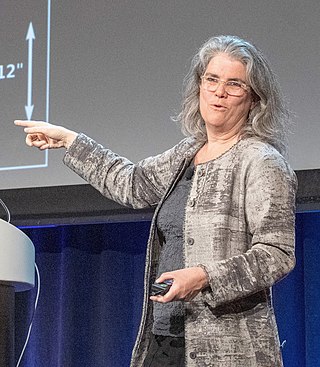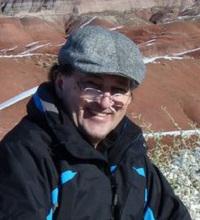Ruth Agnes Daly (born 1958) is an American astrophysicist. [1]
Contents

Ruth Agnes Daly (born 1958) is an American astrophysicist. [1]

Daly obtained a B.A. in Psychology and English from Boston College in 1979 and then switched fields to study Astronomy and Physics at Boston University. She obtained her master's degree and Ph.D. in Astronomy and Physics from Boston University in 1984 and 1987, respectively, working with thesis advisers Alan P. Marscher and Sheldon Glashow. She was a NATO-NSF Postdoctoral Fellow at the Institute of Astronomy in Cambridge from 1987 to 1988, sponsored by Sir Martin Rees. She joined the Physics Department at Princeton University in 1988, first as a Research Associate (1988 to 1989), then as an Instructor (1989 to 1990), and finally as an Assistant Professor (1990 to 1998). She joined the faculty at Bucknell University in 1998, and the faculty at the Pennsylvania State University at the Berks Campus in 1999. She is currently a professor of physics at Penn State University, Berks campus. [2]
Daly conducts theoretical, phenomenological, and observational work in astrophysics. Her main areas of study are cosmology and extragalactic astrophysics. She is most well known for her work on the expansion and acceleration histories of the universe, the use of these histories to determine the contents of the universe, and studies of the properties of supermassive black holes, e.g., as summarized. [3] Non-specialists interested in this work can read about it in the popular literature, such as Sky & Telescope. [4] Some key results, obtained in collaboration with Professor Stanislav George Djorgovski, are that the expansion and acceleration histories of the universe can be determined in a model-independent manner, which does not require that a theory of gravity be specified and does not depend upon the contents of the universe. The results indicate that the universe is accelerating at the present time, and was decelerating in the recent past. Daly has also shown that the properties of outflows from the vicinity of a supermassive black hole can be used to estimate the spin of the black hole. Her ongoing research into the acceleration of the universe and the properties of supermassive black holes is discussed in detail in her publications, linked at her website.
Daly was named a Fellow of the American Physical Society (APS) in 2020, after a nomination from the APS Division of Astrophysics, "for studies of radio properties in supermassive black holes, leading to their use as cosmic rulers, and providing early evidence of their role in cosmic acceleration, and insight into the spin properties of the supermassive black holes that power the outflows". [5]

Andrea Mia Ghez is an American astrophysicist, Nobel laureate, and professor in the Department of Physics and Astronomy and the Lauren B. Leichtman & Arthur E. Levine chair in Astrophysics, at the University of California, Los Angeles. Her research focuses on the center of the Milky Way galaxy.
Andreja Gomboc, is a Slovenian astrophysicist.
Amy J. Barger is an American astronomer and Henrietta Leavitt Professor of Astronomy at the University of Wisconsin–Madison. She is considered a pioneer in combining data from multiple telescopes to monitor multiple wavelengths and in discovering distant galaxies and supermassive black holes, which are outside of the visible spectrum. Barger is an active member of the International Astronomical Union.

Fulvio Melia is an Italian-American astrophysicist, cosmologist and author. He is professor of physics, astronomy and the applied math program at the University of Arizona and was a scientific editor of The Astrophysical Journal and an associate editor of The Astrophysical Journal Letters. A former Presidential Young Investigator and Sloan Research Fellow, he is the author of six English books and 230 refereed articles on theoretical astrophysics and cosmology.

Priyamvada (Priya) Natarajan is a professor in the departments of astronomy and physics at Yale University. She is noted for her work in mapping dark matter and dark energy, particularly with her work in gravitational lensing, and in models describing the assembly and accretion histories of supermassive black holes. She authored the book Mapping the Heavens: The Radical Scientific Ideas That Reveal the Cosmos.

Claudia Megan Urry is an American astrophysicist, who has served as the President of the American Astronomical Society, as chair of the Department of Physics at Yale University, and as part of the Hubble Space Telescope faculty. She is currently the Israel Munson Professor of Physics and Astronomy at Yale University and Director of the Yale Center for Astronomy and Astrophysics. Urry is notable not only for her contributions to astronomy and astrophysics, including work on black holes and multiwavelength surveys, but also for her work addressing sexism and sex equality in astronomy, science, and academia more generally.
Alice Eve Shapley is a professor at the University of California, Los Angeles (UCLA) in the Department of Physics and Astronomy. She was one of the discoverers of the spiral galaxy BX442. Through her time at University of California, Los Angeles (UCLA) she has taught Nature of the Universe, Black Holes and Cosmic Catastrophes, Cosmology: Our Changing Concepts of the Universe, Galaxies, Scientific Writing, AGNs, Galaxies, *and* Writing, and The Formation and Evolution of Galaxies and the IGM. Shapley has committed herself to over a two decades of research and publication in the interest of physics and astronomy.

Laura Ferrarese is a researcher in space science at the National Research Council of Canada. Her primary work has been performed using data from the Hubble Space Telescope and the Canada-France-Hawaii Telescope.
Manuela Campanelli is a distinguished professor of astrophysics and mathematical sciences of the Rochester Institute of Technology, and the director of its Center for Computational Relativity and Gravitation and Astrophysics and Space Sciences Institute for Research Excellence. Her work focuses on the astrophysics of merging black holes and neutron stars, which are powerful sources of gravitational waves, electromagnetic radiation and relativistic jets. This research is central to the new field of multi-messenger astronomy.
Jedidah C. Isler is an American astrophysicist, educator, and an active advocate for diversity in STEM. She became the first African-American woman to complete her PhD in astrophysics at Yale in 2014. She is currently an assistant professor of astrophysics at Dartmouth College. Her research explores the physics of blazars and examines the jet streams emanating from them. In November 2020, Isler was named a member of Joe Biden's presidential transition Agency Review Team to support transition efforts related to the National Aeronautics and Space Administration.
G. Mark Voit is an American physicist and professor in the Department of Physics and Astronomy at Michigan State University. His most cited solely-authored paper is "Tracing Cosmic Evolution with Clusters of Galaxies", in Reviews of Modern Physics, at Michigan State University. He is an Elected Fellow of the American Association for the Advancement of Science. His research involves theoretical investigations of clusters of galaxies, galaxy evolution, and the role of supermassive black holes in galaxy evolution. Voit is an expert in the physics of astrophysical gas and dust.
Juna Kollmeier is an astrophysicist from the US. She is currently employed at the Carnegie Institution for Science and is the director of the fifth phase of the Sloan Digital Sky Survey, which made its first observations in October, 2020. She has been named director of the Canadian Institute for Theoretical Astrophysics, located at the University of Toronto, and will take up this position in July, 2021.

Burçin Mutlu-Pakdil is a Turkish-American astrophysicist, and Assistant Professor at Dartmouth College. She formerly served as a National Science Foundation (NSF) and Kavli Institute for Cosmological Physics (KICP) Postdoctoral Fellow at the University of Chicago. Her research led to a discovery of an extremely rare galaxy with a unique double-ringed elliptical structure, which is now commonly referred to as Burcin's Galaxy. She was also a 2018 TED Fellow, and a 2020 TED Senior Fellow.

Angela Villela Olinto is an astroparticle physicist and the Albert A. Michelson Distinguished Service Professor at the University of Chicago as well as the dean of the Physical Sciences Division. Her current work is focused on understanding the origin of high-energy cosmic rays, gamma rays, and neutrinos.
Daryl Haggard is an American-Canadian astronomer and associate professor of physics in the Department of Physics at McGill University and the McGill Space Institute.

Rita M. Sambruna Commander OMRI (Hon) is an Italian-American astrophysicist and is the Deputy Director of the Astrophysics Science Division at National Aeronautics and Space Administration's (NASA) Goddard Space Flight Center. From September 2022 to May 2023, she was the Acting Deputy Director of the Science Exploration Directorate at Goddard. Rita held the Clare Boothe Luce Professorship in Physics and Astronomy at George Mason University in 2000-2005.

Péter István Mészáros is a Hungarian-American theoretical astrophysicist, best known for the Mészáros effect in cosmology and for his work on gamma-ray bursts.
Lucy Marie Ziurys is an American astrochemist known for her work on high-resolution molecular spectroscopy. She is Regent's Professor of Chemistry & Biology and of Astronomy at the University of Arizona.
Rosalba Perna is an Italian and American theoretical astrophysicist whose research concerns high-energy cosmic sources including gamma-ray bursts and neutron star mergers. She has also studied exoplanets and the growth of supermassive black holes. She is professor of physics and astronomy at Stony Brook University.

Marc S. Seigar is an astrophysicist, academic and author. He is the Dean of the College of Natural Sciences and Mathematics, and a Professor of Physics and Astronomy at the University of Toledo.